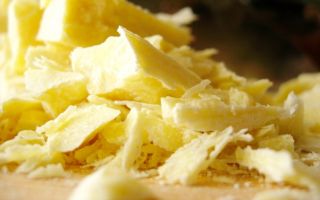Content
- 1 What is palm oil made of
- 2 Varieties of palm oil
- 3 Composition and nutritional value of palm oil
- 4 Why is palm oil useful for humans
- 5 Can palm oil be given to children
- 6 Slimming Palm Oil
- 7 The use of palm oil in traditional medicine
- 8 Palm oil in cosmetology
- 9 Daily intake of palm oil
- 10 Harm of palm oil and contraindications
- 11 What foods contain palm oil
- 12 How to determine the presence of palm oil in foods
- 13 Conclusion
- 14 Reviews
Palm oil is one of the most controversial foods around. What are the benefits and harms of palm oil, and is it generally suitable for consumption?
What is palm oil made of
The raw material for the production of the product is the oil palm - or rather, its fruits and seeds. Ordinary oil, which can be purchased in stores, is made from the pulp of the fruit - it is boiled down, and then the separated fat is collected and subjected to cleaning and processing.
Oil is also produced from the seeds of palm fruits - only it is called differently, "palm kernel", and has completely different properties.
Varieties of palm oil
The oil obtained from palm fruits is classified into three main varieties.
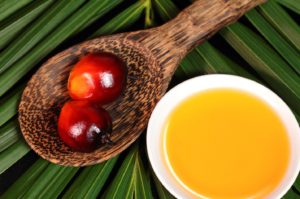
- Unprocessed red oil - This is a fairly useful product, made by cold pressing with the maximum preservation of valuable substances. The use of red palm oil is that it contains a huge amount of carotene and coenzyme Q. Valuable properties strengthen the immune system, slow down the aging process. The product is expensive, it is found mainly on pharmacy counters. It is rarely used for the manufacture of baked goods and other products, but in general, use in the food industry is economically unprofitable.
- Refined oil, refined and deodorized - the most inexpensive and popular variety. The benefits of the product are much less, since the lion's share of valuable substances is lost during processing. The composition contains both vitamins and compounds that are potentially harmful to health. The refined variety is found everywhere - in confectionery, in cheeses and sauces, in semi-finished products.
- Technical oil - the most harmful variety with a low degree of purification after processing. The product is saturated with trans fats, provokes an increase in cholesterol levels and even cancer. In principle, it should not be used for food, since it is intended for the pharmaceutical sector and industry - however, it is used by unscrupulous manufacturers. It is the properties of technical fat that are largely responsible for the poor reputation of the product.

Composition and nutritional value of palm oil
The richest composition is the red oil that has not been processed. A useful product contains the following substances:
- unsaturated fatty acids - linoleic and oleic;
- saturated fatty acids - primarily palmitic;
- vitamins A, E, K1 and B4, B3;
- valuable coenzyme Q10;
- stearic acid;
- triglycerols and tocopherols;
- carotenoids;
- iron and phosphorus;
- lecithin and phytosterols.
The calorie content of 100 g of the product is quite high - 899 calories, and the entire volume is occupied by fats.

Why is palm oil useful for humans
If we consider the most natural variety of the product, then the benefits of palm oil for the body are that it:
- has an antioxidant effect on the body;
- strengthens the visual apparatus due to the high content of vitamin A;
- serves as a good prevention of cancerous tumors;
- strengthens the joints;
- has a wound healing and anti-inflammatory effect;
- tones up the body.
Is palm oil good for pregnant and lactating women
During the period of bearing a child, only untreated red pomace is allowed to be consumed - as a rich and useful source of vitamins. You can take it in an amount of no more than 1 teaspoon per day. But a refined product should not be introduced into the diet - on the contrary, it is better to exclude all "palm" dishes from the diet.
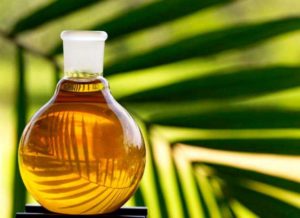
It is strictly forbidden to consume excessively acidic solid fat. The harm consists in a huge amount of cholesterol and a negative effect on the absorption of calcium.
The same applies to the lactation period. In the absence of negative manifestations on the part of the baby, you can use useful red oil 1 spoon per day, its properties will be beneficial. But any other species from the mother's diet must be removed.
Can palm oil be given to children
For the first time, it is allowed to introduce a healthy natural product into the infant's diet no earlier than at the age of 6 months. And we are talking only about untreated healing oil, which can be offered in half a teaspoon. Together with the product, the baby's body will receive vitamins A and E. By the age of 3, the dosage can be increased to 1 teaspoon.
Refined palm oil for newborns is strictly prohibited, as are solid varieties.
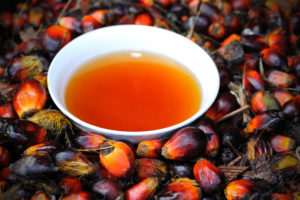
Slimming Palm Oil
Despite the fact that there can be benefits from a natural product, it will only be harmful on a diet - the calorie content is too high, and there are no fat burning properties.
The use of palm oil in traditional medicine
The beneficial properties of the product are highly valued in traditional medicine. They are treated with:
- eye diseases - glaucoma, conjunctivitis;
- skin dermatitis;
- a cold;
- inflammation of the urinary tract;
- lack of hemoglobin;
- joint ailments.
Also, a useful product helps with stress and anxiety, with chronic fatigue, during menopause or with menstrual pain.
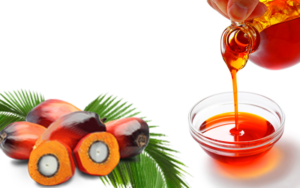
From periodontal disease
In case of inflammation of the mucous membranes of the mouth, you can wet a sterile gauze napkin in red oil and apply it to the gums for a few minutes. You need to repeat the procedure for 2 weeks daily.
For joint pain
For arthritis or gout, 15 ml of palm pomace is mixed with other ingredients - for example, a few drops of lemon, pine or lavender oil. The agent is rubbed into sore joints, it is recommended to continue treatment for at least 2 weeks.
For dermatitis
For psoriasis, lichen or eczema, you can mix 80 ml of the product with 20 ml of walnut squeeze, add a teaspoon of birch tar, stir thoroughly. Problem areas of the skin are lubricated twice a day for 14 days.
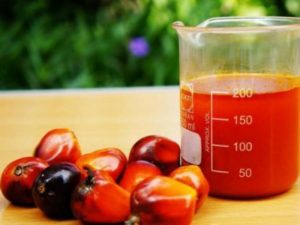
Palm oil in cosmetology
Even industrial cosmetology is actively using the beneficial properties of the product. In cosmetics, palm oil is found in masks and creams for dry and aging skin, it is also included in regular and scented candles. There is palm oil in the soap, which gives it a solid consistency.
The product is also used in home beauty recipes.
For facial skin
The product perfectly softens dry skin, has a rejuvenating and anti-inflammatory effect.
- A mask based on palm and apricot oils taken in equal proportions will remove the first wrinkles and restore skin tone. The mixture is kept on the face for about 15 minutes until it is absorbed. Then you can wash with warm water.
- The condition of dry skin will be improved by a mask of palm and olive oils. Before use, you need to wash, and then apply the product on a wet face with gentle, lightly patting movements.
The benefits of both masks will be maximized if you do them for 2 weeks in a row, every 2 - 3 days.
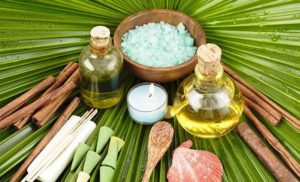
For hair
Since the product contains a large amount of antioxidants, vitamin E and carotenoids, the hair becomes softer, more manageable, and gains shine.
Using the hair care product is very simple.
- To make your hair stronger and more voluminous, just add a couple of drops of squeeze to your regular shampoo.
- To soften too dry scalp, 2 - 3 times a week you can make masks based on this remedy and other vegetable oils, rubbing them into the hair roots for half an hour.
For body
The properties of a liquid or melted product are great for improving skin tone throughout the body.
- For anti-cellulite massage, you need to mix 3 teaspoons of squeeze from palm fruits with a few drops of olive, lemon, dill oil. The product is rubbed twice a day into problem areas with careful but strong movements.
- The product will make the postoperative sutures less visible if you mix it in the amount of 3 spoons with a few drops of clove, mint, rosemary oil. The scar is smeared with a product twice a day for 10 days, then they take a break for a couple of weeks, then resume the procedure.

Daily intake of palm oil
The harmless dosage of the product depends on the variety. So, the most useful unprocessed red oil can be consumed at 2 teaspoons per day. As for the purified species, the total daily amount should not exceed 10 g.
Harm of palm oil and contraindications
The benefits of a quality product are undeniable - and yet some of the properties cause the oil's bad reputation. The harm lies in the fact that the processed and refined product:
- contains too many saturated fatty acids and has a high melting point - that is, it raises cholesterol levels and is bad for the heart;
- may contain carcinogens and contribute to the oncology;
- leads to weight gain and obesity;
- provokes the development of diabetes, atherosclerosis and Alzheimer's disease.
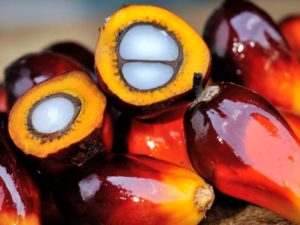
Thus, the product is strictly prohibited for use with a tendency to the listed diseases - with gastric and heart ailments, with excess weight, with an increased level of harmful cholesterol.
What foods contain palm oil
One way or another, palm fruit fat is included in so many foods. For example, you can find palm oil in sweets, margarines and chocolate, ice cream and chips. Raw materials are used in the manufacture of condensed milk and mayonnaise, sausages and semi-finished products, bakery products - they are very cheap and at the same time have preservative properties, that is, they extend the shelf life of products.
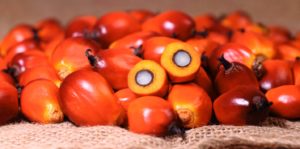
The product is found even in infant formula. The use of palm oil in baby food is that it saturates the baby's body with vitamins A and E. And most importantly, palmitic acid, which can potentially harm, is still needed in small quantities for the child's body. It is a component of mother's milk and is especially important for babies growing on artificial formula.
How to determine the presence of palm oil in foods
In small amounts, palm oil does not cause serious harm. But for a daily diet, it is better to choose foods without this component. Knowing if a product contains an unwanted ingredient is fairly straightforward.
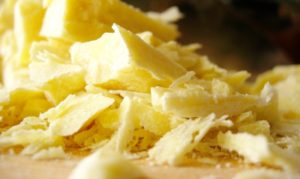
- Palm oil is a good preservative. If a perishable product - for example, a dairy product - has a too long shelf life, then this indicates the presence of an ingredient in the composition.
- If the manufacturing technology of the product does not allow the use of palm oil, but it is still in the composition, this will be reflected in the name. For example, condensed milk will be called "milk-containing product", sour cream - "sour cream", and so on.
- If the product is too low in price, then it is likely that the manufacturer has saved on ingredients and introduced cheap raw materials into the composition, despite the possible harm.
Of course, you need to carefully read the composition of the products - the presence of fat can be directly indicated in it, sometimes the ingredient is hidden under the general name of "vegetable oil".
Conclusion
The benefits and harms of palm oil depend on the variety, on the degree of naturalness, on the daily amount when consumed. It is best to opt for unprocessed red pomace, the properties of which are the most valuable, and use other types in minimal doses.
Reviews
Alekseeva Svetlana Igorevna, 37 years old, Yekaterinburg
I never buy groceries with palm oil in the store, but at home I always have red palm oil. I was convinced of its effectiveness several times - a useful product helped with gum inflammation, colds, pain in the knees.
Astakhova Larisa Mikhailovna, 28 years old, Omsk
For several years now I have been using palm oil for my hair - I make masks with a mixture of different oils, I add the product to the conditioner balm. My hair is naturally very dry, often splits, and is difficult to comb - but the product really works wonders. I treat my head with it several times a year for two or three weeks in a row - and for another couple of months my hair pleases with volume and healthy strength.

